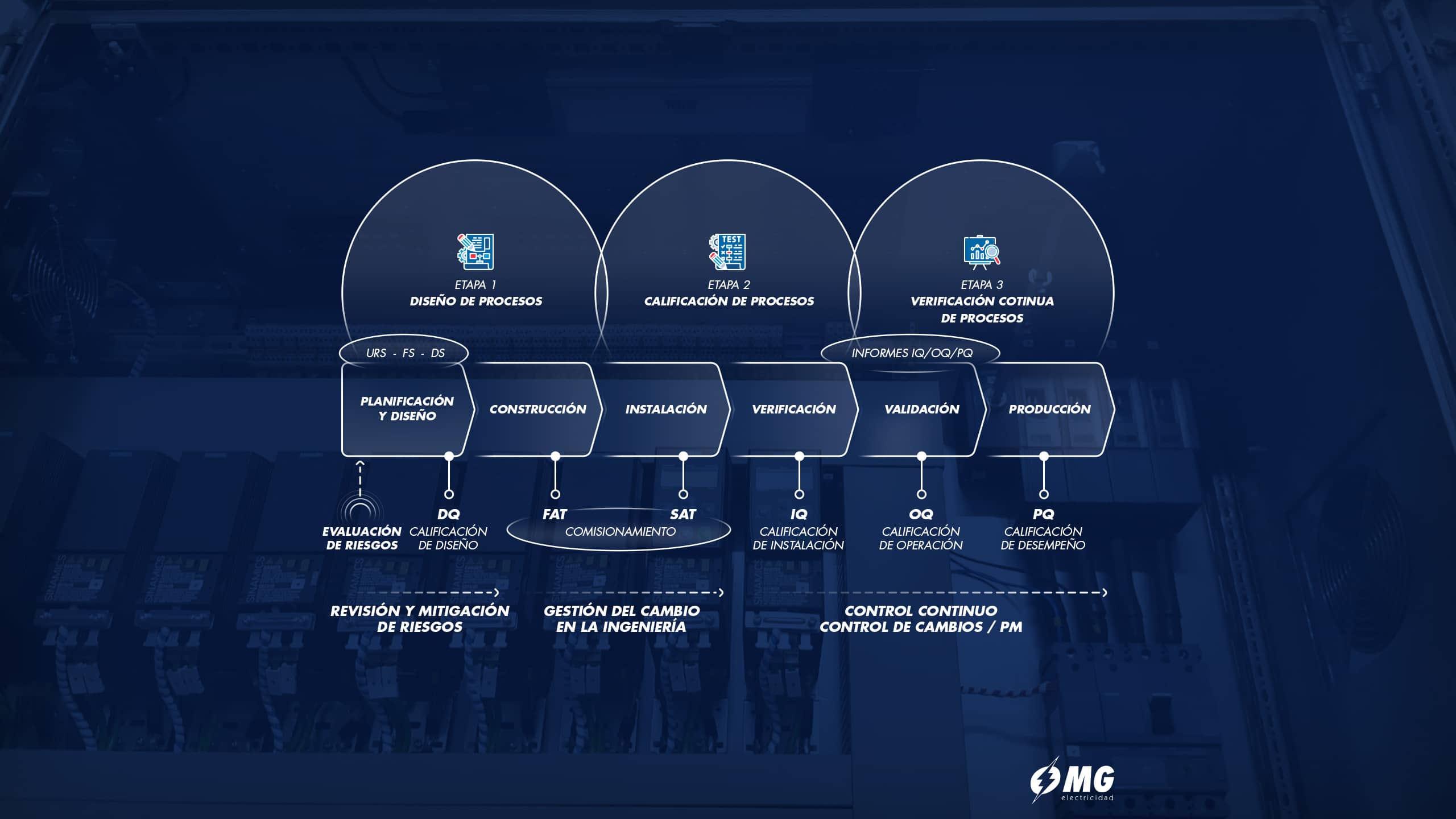FAT Test
FAT testing is a necessary protocol in any industrial electrical installation project. When designing and manufacturing new equipment, it is very easy to find incompatibilities between components. The more complex the assembly of an electrical panel, the greater the probability of errors. Por ello, se hace imprescindible el testeo de dichos sistemas antes de su embalaje y envío a la fábrica de destino.
The well-known FAT tests come from the Factory Acceptance Test concept, which is nothing more than the verification of the correct operation of the equipment at its place of manufacture.
FAT tests in the automation area are not mandatory, but at MG Electricidad we have adopted them as a standard to guarantee the quality of our products, for example in our complex equipment such as automation systems.
FAT tests for validation
What is a FAT test?
A FAT test is basically an operational test that we, as suppliers and installers, carry out on new equipment before its final assembly. This test is carried out when the manufacture of the equipment has been completed, following a series of processes and parameters previously established with the client.
FAT tests ensure compliance that the installation performs all purposes, functions and process automation properly. These tests are based on the performance, quality, safety, maintainability and functionality of the hardware and software, according to the conditions previously agreed with the customer.

FAT equipment test protocol
A FAT test protocol where all important components are listed is essential for a good verification. A checklist reduces costly project delays by ensuring that all details are taken into account.
Although the protocol for FAT testing of equipment can vary, the following steps are commonly found:
- Review of standards and directives applicable to each automation or electrical installation.
- The components meet the theoretical specifications agreed with the customer's requirements.
- Ensure the electrical connections are correct and follow the wiring diagram.
- The relevant documents are available and referenced.
- La automatización o instalación eléctrica cumple la función buscada.
- The software works well and is easy to understand.
- Equipment settings suitable for the correct functioning of the equipment and its protection.
- The operational alarms are activated correctly.
- The diagnostic functions work and help the staff in charge.
- The safety systems work and prevent hazards.
- The start and stop processes are safe and meet the requirements of automation.
- The stress tests are passed satisfactorily.
After the tests have been carried out, a report is made with the data obtained. In the event that the automation does not pass the FAT tests, the necessary corrective actions are carried out until it passes the tests.
FAT test format for electrical panels
Factory acceptance testing ensures that the switchgear meets all requirements and is ready for trouble-free turnkey installation. Such testing is beneficial for both the end users and the manufacturer.
Any malfunctions are monitored before the equipment leaves our workshop and can be easily rectified by our team of fitters. In this way, FAT helps to control project timelines and costs.
Although the FAT test is optional, it is best not to omit it. If problems occur after installation of the electrical panel, it can lead to costly downtime and emergency repairs.
In the industrial automation environment, FAT testing has become an indispensable element in a production process, providing a multitude of benefits:
- Accessibility requirements for operation and maintenance are assessed, thus allowing problems to be detected that were not visible during the design and assembly phases.
- Simplify the correction of errors, avoiding sending a team with problems.
- Electrical connections are secured.
- Se recapitula la documentación relacionada con el equipo. De esta manera, rebajamos los costes de fabricación, al optimizar todos los procesos para disminuir el número de errores.
- We guarantee that the equipment complies with the schematics and project specifications.
- The quality offered by the product to the end customer is increased, improving their level of satisfaction with us.
Differences between FAT and SAT tests
FAT and SAT tests, by definition, pursue the same objective, namely to ensure proper operation within defined quality and safety parameters.
While SAT tests are performed at the location of the equipment, FAT tests are performed at the factory or workshop, before the product or equipment leaves for its destination. However, there is often confusion as to what is a fat and sat test, so we will clarify the different points that characterise them.
Place of assembly
The FAT test is carried out in our assembly workshop, before moving the equipment, while the SAT is carried out at the destination, where it has been installed.
Operating
The FAT is done to check the equipment, while the on-site acceptance test is done with all interfaces connected, where you will see the actual operation under factory conditions...
Duration
FAT test times are relatively short while SAT is longer.
Enviroment
Como la FAT se llevan a cabo en nuestras instalaciones, el entorno en sí no es extremo, mientras para las SAT se trata del entorno real.
Documentation
Very detailed for FAT tests, while for SAT tests it is much simpler.
Advantages of FAT testing
In short, the objective of FAT testing is to establish a level and guarantee product quality parameters.













